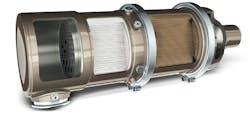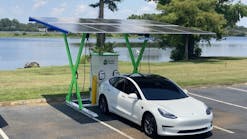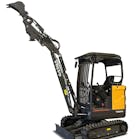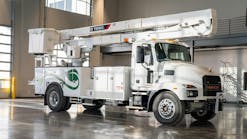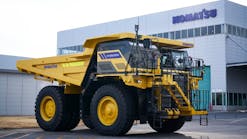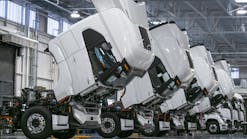Reprinted with the permission of Equipment Manager magazine, the magazine of AEMP.
Environmental Protection Agency (EPA) mandates for Tier 4 engines call for such a significant reduction from Tier 3 levels in soot (particulate matter) and toxic chemicals ejected from diesel engines during operation (nitrous oxide) that the government decided to introduce Tier 4 ratings in two phases based on horsepower.
The Tier 4-Interim phase began in 2008 for engines with less than 75 horsepower. Last year covered engines rated over 175 horsepower, and this year engines rated between 75 and 174 horsepower are required to meet the mandates. Tier 4-Final, using even more sophisticated technology to address NOX emissions, is targeted for 2014 and 2015.
To meet EPA standards for Tier 4-Interim engines, design engineers have come up with the proverbial alphabet soup of technology to accomplish the task:
- DPF (diesel particulate filter), used to collect particulate matter generated by combustion. Exhaust gas is forced to flow through the filter where the particulate matter is trapped.
- DOC (diesel oxidation catalyst), a device using a chemical process to break down exhaust stream pollutants from diesel engines, turning them into less harmful configurations.
- SCR (selective catalytic reduction), used in the burn-off of soot.
- DEF (a urea diesel exhaust fluid), used in SCR to lower NOX concentration in the exhaust emissions from diesel engines.
And to really stir up the concoction, says Doug Mihelick, commercial manager in large power systems growth market at Caterpillar Mossville Engine Center, “Most Tier 4-Interim engines are equipped with an OCV (open crankcase ventilation) filter. This filter is intended to remove liquid hydrocarbons and particulates that are normal constituents of crankcase emissions.” These new ancillary components of Tier 4 engines must be changed periodically. “Our interval is every 2,000 hours,” he says.
DPF Maintenance
At 4,500 hours, the DPF must be removed and cleaned out, but the process requires special service tooling at either the manufacturer or at the OEM-dealer facility, according to Mihelick. Cleaning the DPF requires sophisticated tests and cleaning equipment.
“The testing of the filter will determine the viability-serviceability of the filter first, then come additional post-cleaning tests,” Mihelick says. “Also, some states classify the removed ash as a hazardous material. That means the ash requires special handling and proper disposal.”
The cleaned filters can be reused, with OEMs such as Caterpillar offering factory cleaned/remanufactured replacements.
Thanks to Tier 3 technology, many, if not most, fleet managers are already familiar with servicing cooled exhaust gas recirculation, or CEGR. Brad Stemper, manager of the commercial product training group for Case Construction Equipment, says the CEGR system extracts exhaust from the exhaust manifold and re-circulates the exhaust back to the combustion chambers. This process lowers the combustion temperature. The lowered combustion temperature produces lower nitrogen oxides or NOX levels.
“That’s all done right in the engine to the point that only one or two small components, just like any other engine, need to be managed,” he says. There are no maintenance or wear items for the fleet manager to be concerned with.
With the Tier 4-Interim CEGR system, an aftertreatment system (the diesel oxidation catalyst, or DOC, and the diesel particulate filter, or DPF) is used to trap particulate matter or soot. A primary concern for fleet managers is to make certain the quality of the oil and the quality of the fuel meet required specifications. Low-ash oil (CJ-4) is necessary, and ultra low sulfur diesel fuel must be used.
“From the filtration perspective, things have changed over the last five years,” says Philip Johnson, director of new business development for engine liquid filtration at The Donaldson Co. “During the introduction of Tier 4, we also saw the introduction of ultra low sulfur diesel and introduction of biodiesel, for instance. This has created a range of challenges, not least of which is water removal from diesel fuels. We’ve had common rail fuel injection systems since early 2000, and one thing that is happening is that the injection pressures are getting significantly higher. Right now many of the systems are targeting 30,000-psi working pressure. There’s talk of next-generation systems going up to 80,000.”
Clean Fuel Required
What this means, Johnson says, is that “super-high fuel cleanliness levels” become the most important factor for fleet managers responsible for equipment. “No other equipment requires a cleaner product than the fuel injection system,” Johnson says. “I don’t think you will see systems lasting more than a few thousand hours if fleet managers don’t maintain their fuel systems properly.”
Johnson says a debate is going on when it comes to exhaust gas recirculation (EGR). One view is that EGR will reach a point where urea will be required in the exhaust system. The other side challenges this view.
“There is a competition among engine manufacturers on this point,” he says. “I’m not in a position to say who is going to win that war, but certainly that appears to be the direction the two camps are following.”
Johnson says there are merits to both schools of thought, but certainly what has to play into the debate is “the real world in maintenance. Having something extra to carry around and maintain is a real problem.”
Dave Hahn, manager-technical support specialist for Volvo Construction Equipment, says, “Diesel exhaust fluid is a urea solution used in SCR to lower NOX concentration in the exhaust emissions from diesel engines. It works with the heat of the exhaust and a catalyst to convert NOX into nitrogen and water vapor, two harmless and natural components of the air we breathe.”
OEMs actually got a jump on the introduction schedule of Tier 4-Interim engines. “In 2011, more Interim Tier 4-powered programs were released than any other year,” says Brian Birkenholz, senior field service engineer for John Deere Power Systems. “If you think of it as a bell curve, we are on a downward slope as far as program release is concerned.”
When maintaining the ancillary components on these new engines, the DOC/DPF combination will require scheduled maintenance at an extended hour level, he says. “Under normal operating conditions, that is going to be 4,500 hours for engines greater than 174 horsepower and 3,000 hours for engines lower than 174 horsepower.”
OCV filters will also require consideration, he says. “Similar to oil and fuel filters, ventilation filters are not serviceable. You have to replace them. You simply take the canister off and swap it out. The fleet manager exchanges the old one for a new filter that the local dealer brings out.”
Engine Coolants
Coolant changes, too, Birkenholz points out, and new coolant is a yellowish-gold color. The older coolant was green. “The new coolant, along with the new CJ-4 oil and ultra low sulfur content diesel fuel, should be used with Interim Tier 4 engines.”
Birkenholz says the biggest challenge fleet managers will face is educating the machine operator to understand what is going on when an exhaust filter cleaning is taking place. Regeneration of an exhaust filter is either passive or active. Passive regeneration takes place behind the scenes and doesn’t interrupt the work. It happens naturally as the engine is running under heavy loads, creating sufficient heat to passively regenerate the exhaust filter. Depending on the working of the engine, exhaust temperatures may not be sufficient enough to create the heat necessary to oxidize the particulate matter trapped in the exhaust filter. If conditions for passive regeneration cannot be achieved, then particulate matter must be removed using active regeneration. Active regeneration injects a small amount of fuel into the exhaust stream in order to elevate exhaust temperatures capable of oxidizing the trapped particulate matter.
“Fleet managers often run these machines around the clock, and they may have, for instance, operators with varying degrees of technical aptitudes,” Birkenholz says. “It really comes down to making sure operators understand how regeneration works, so they reduce the amount of time the machine idles.”
“When you’re not running perfectly to generate [enough] heat, you will collect particulate matter,” Stemper says. “The filter [DPF] becomes restricted enough to interrupt good air flow through the exhaust system. An indicator in the cab tells the operator regeneration is required. Diesel fuel is injected into the exhaust system, where the diesel fuel reacts with the DOC and creates more heat at which point the particulate matter is burned off.”
After 15 or 20 minutes the filter will be clean enough to start running the machine again, he says.
Shop technicians must be trained in the new systems, yet Stemper says that variations in how different OEMs communicate with customers can cause confusion.
“Customers are actually getting confused due to the difference in terms for the same components,” he says. “It is the responsibility of the company to identify what the engine technology does. When the customer understands what the component does, then you can replace the name and still tell what the function is. Although the system is complicated, the process of identifying should be easy and straightforward.”
Case communicates to customers from several directions: the operator’s manual, the OEM and Case dealerships.
“The manual and the displays are our first levels of communications in telling the customer what’s going on,” Stemper says. “The second direction is from our dealerships, which is a valuable resource for customers to keep the machine maintained and operating correctly. Dealership technicians are well versed and familiar with the machines simply because they deal with them on a daily basis. Also, during delivery there is a walk-around review on what can be expected and how the unit operates more efficiently so it regenerates less.”
Birkenholz says Deere offers formal training to its dealer network, but not for user-fleet technicians. Instead, “We have a quick-reference guide starting with Interim Tier 4 tailored for PM maintenance. It explains, for example, what an indicator light that comes on in the cab means, tells the customer here is the motor oil we require, and this is what coolant we require. It’s an easier way to decipher the requirements for maintenance.”
Volvo’s Hahn says to answer yes or no in determining whether technician training is required or necessary is difficult. “The fleet manager must decide if his maintenance personnel have sufficient technical training and background, along with specialized tooling, to address troubleshooting and repair of the exhaust systems,” he says. “General maintenance would only require a cursory overview of DPF servicing.”
Everything a customer needs to know is contained in the operation and maintenance manual in Cat equipment, Mihelick says.
Fleet managers can expect to see even more combinations of components, existing and new, on the technology horizon. For Tier 4-Final, Mihelick anticipates that there will be much more extensive use of SCR systems in meeting NOX reduction mandates.
“[Deere is] continuing to develop technology that will achieve the required standards Final Tier 4 emissions regulations,” says Birkenholz. “We don’t know yet what that will be, but I can say that cooled-EGR, variable geometry turbocharging, and exhaust filters are going to be the foundation meeting that regulation. We are now in the stages of evaluating emerging technology, the reliability of it, and what effectiveness we can expect from it.” EM
